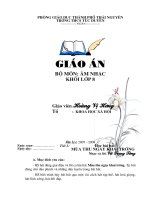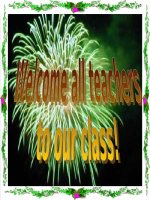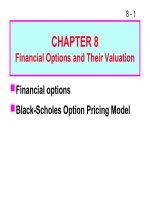bài giảng chapter 8 financial options and their valuation
Bạn đang xem bản rút gọn của tài liệu. Xem và tải ngay bản đầy đủ của tài liệu tại đây (77.47 KB, 23 trang )
8 - 1
Financial options
Black-Scholes Option Pricing Model
CHAPTER 8
Financial Options and Their Valuation
8 - 2
An option is a contract which gives
its holder the right, but not the
obligation, to buy (or sell) an asset at
some predetermined price within a
specified period of time.
What is a financial option?
8 - 3
It does not obligate its owner to
take any action. It merely gives
the owner the right to buy or sell
an asset.
What is the single most important
characteristic of an option?
8 - 4
Call option: An option to buy a
specified number of shares of a
security within some future period.
Put option: An option to sell a
specified number of shares of a
security within some future period.
Exercise (or strike) price: The price
stated in the option contract at which
the security can be bought or sold.
Option Terminology
8 - 5
Option price: The market price of
the option contract.
Expiration date: The date the
option matures.
Exercise value: The value of a call
option if it were exercised today =
Current stock price - Strike price.
Note: The exercise value is zero if
the stock price is less than the
strike price.
8 - 6
Covered option: A call option
written against stock held in an
investor’s portfolio.
Naked (uncovered) option: An
option sold without the stock to
back it up.
In-the-money call: A call whose
exercise price is less than the
current price of the underlying
stock.
8 - 7
Out-of-the-money call: A call
option whose exercise price
exceeds the current stock price.
LEAPS: Long-term Equity
AnticiPation Securities that are
similar to conventional options
except that they are long-term
options with maturities of up to
2 1/2 years.
8 - 8
Exercise price = $25.
Stock Price Call Option Price
$25 $ 3.00
30 7.50
35 12.00
40 16.50
45 21.00
50 25.50
Consider the following data:
8 - 9
Create a table which shows (a) stock
price, (b) strike price, (c) exercise
value, (d) option price, and (e) premium
of option price over the exercise value.
Price of Strike Exercise Value
Stock (a) Price (b) of Option (a) - (b)
$25.00 $25.00 $0.00
30.00 25.00 5.00
35.00 25.00 10.00
40.00 25.00 15.00
45.00 25.00 20.00
50.00 25.00 25.00
8 - 10
Exercise Value Mkt. Price Premium
of Option (c) of Option (d) (d) - (c)
$ 0.00 $ 3.00 $ 3.00
5.00 7.50 2.50
10.00 12.00 2.00
15.00 16.50 1.50
20.00 21.00 1.00
25.00 25.50 0.50
Table (Continued)
8 - 11
Call Premium Diagram
5 10 15 20 25 30 35 40 45 50
Stock Price
Option value
30
25
20
15
10
5
Market price
Exercise value
8 - 12
What happens to the premium of the
option price over the exercise
value as the stock price rises?
The premium of the option price over the
exercise value declines as the stock
price increases.
This is due to the declining degree of
leverage provided by options as the
underlying stock price increases, and
the greater loss potential of options at
higher option prices.
8 - 13
The stock underlying the call option
provides no dividends during the call
option’s life.
There are no transactions costs for
the sale/purchase of either the stock
or the option.
R
RF
is known and constant during the
option’s life.
What are the assumptions of the
Black-Scholes Option Pricing Model?
(More )
8 - 14
Security buyers may borrow any
fraction of the purchase price at the
short-term risk-free rate.
No penalty for short selling and sellers
receive immediately full cash proceeds
at today’s price.
Call option can be exercised only on its
expiration date.
Security trading takes place in
continuous time, and stock prices move
randomly in continuous time.
8 - 15
V = P[N(d
1
)] - Xe
-r
RF
t
[N(d
2
)].
d
1
= .
σ t
d
2
= d
1
- σ t.
What are the three equations that
make up the OPM?
ln(P/X) + [r
RF
+ (σ
2
/2)]t
8 - 16
What is the value of the following
call option according to the OPM?
Assume: P = $27; X = $25; r
RF
= 6%;
t = 0.5 years: σ
2
= 0.11
V = $27[N(d
1
)] - $25e
-(0.06)(0.5)
[N(d
2
)].
ln($27/$25) + [(0.06 + 0.11/2)](0.5)
(0.3317)(0.7071)
= 0.5736.
d
2
= d
1
- (0.3317)(0.7071) = d
1
- 0.2345
= 0.5736 - 0.2345 = 0.3391.
d
1
=
8 - 17
N(d
1
) = N(0.5736) = 0.5000 + 0.2168
= 0.7168.
N(d
2
) = N(0.3391) = 0.5000 + 0.1327
= 0.6327.
Note: Values obtained from Excel using
NORMSDIST function.
V = $27(0.7168) - $25e
-0.03
(0.6327)
= $19.3536 - $25(0.97045)(0.6327)
= $4.0036.
8 - 18
Current stock price: Call option value
increases as the current stock price
increases.
Exercise price: As the exercise price
increases, a call option’s value
decreases.
What impact do the following para-
meters have on a call option’s value?
8 - 19
Option period: As the expiration date
is lengthened, a call option’s value
increases (more chance of becoming in
the money.)
Risk-free rate: Call option’s value
tends to increase as r
RF
increases
(reduces the PV of the exercise price).
Stock return variance: Option value
increases with variance of the
underlying stock (more chance of
becoming in the money).
8 - 20
Put-Call Parity
Portfolio 1:
Put option,
Share of stock, P
Portfolio 2:
Call option, V
PV of exercise price, X
8 - 21
Payoff at Expiration if P<X
Portfolio 1:
Put: X-P
Stock: P
Total: X
Porfolio 2:
Call: 0
Cash: X
Total: X
8 - 22
Payoff at Expiration if P≥X
Portfolio 1:
Put: 0
Stock: P
Total: P
Porfolio 2:
Call: P-X
Cash: X
Total: P
8 - 23
Payoffs are Equal,Values Must Be Equal.
Put-Call Parity Relationship
Put + Stock = Call + PV of Exercise Price
t
RF
r
t
RF
r
XePVPut
XeVPPut
−
−
+−=
+=+









